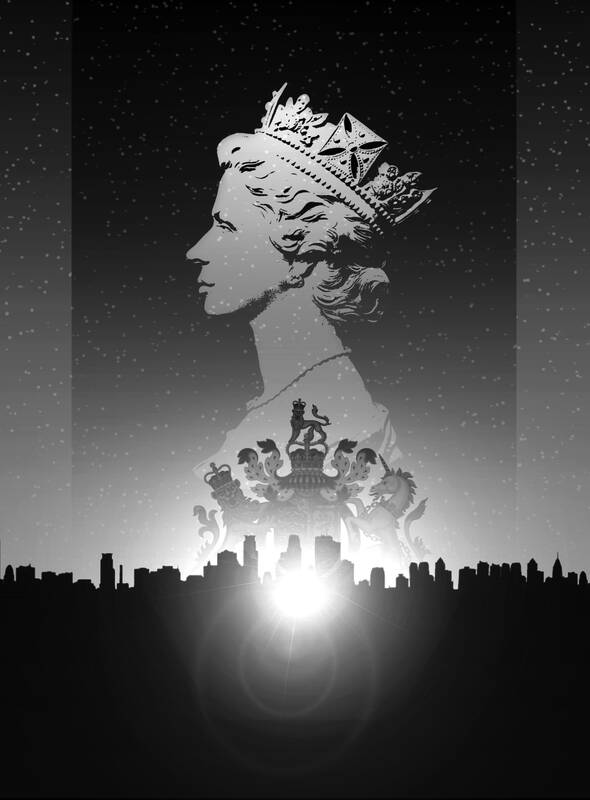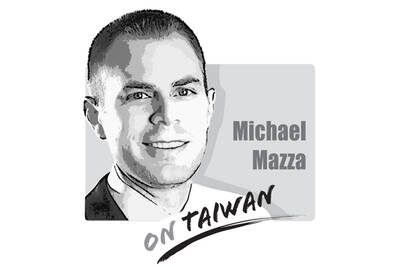Assessing Britain’s monarchy as a brand might, to some, seem superficial — even sacrilegious, but not to the royals, who have seen themselves as a family business ever since George VI nicknamed them “The Firm.”
Setting aside the semiotic parallels between flags and logos, anthems and jingles, mottoes and taglines — the British monarchy is a global brand, and Queen Elizabeth II was its brand ambassador.
With the possible exception of Jesus Christ, Elizabeth II surely had the most reproduced likeness in human history. There are, for instance, 4.7 billion banknotes and 29 billion coins with her profile circulating in the UK alone — a personal and institutional logotype that has existed for seven decades and, at its peak, extended across at least 33 other countries.

Illustration: Yusha
To understand how embedded the sovereign is within Brand Britannia, consider the changes being made to the country’s infrastructure. Some have been immediate — oaths of office, legal proceedings, the national anthem. Others are certain to overlap for decades — post-box ciphers, passport wording, prayer books.
In time, Charles III will be seamlessly woven into the fabric of the state, and God Save the King will cease to sound quite so Shakespearean.
If this all seems drearily constitutional, it is worth remembering how much Elizabeth II did to modernize the royal brand. Spurred by a fading of deference and the demands of the media, the queen — encouraged by Prince Philip — pioneered daring innovations to draw the sovereign closer to her subjects, from allowing her coronation to be televised to mixing with hoi polloi on royal walkabouts.
In 1969, she even gave consent for a groundbreaking, year-long “fly on the wall” BBC documentary.
There were, of course, personal stumbles. The most poignant was in 1966, when Elizabeth II delayed visiting Aberfan in the aftermath of the coal mine landslide that killed 116 children and 28 adults. The most perilous was in 1997, when she failed to respect the depth of public anguish following the death of Princess Diana.
By and large, though, such missteps — born not of callousness, but of caution — were forgiven. In time, the queen’s confidence grew, reaching a dual-branded climax when she appeared with James Bond to open the 2012 London Olympics, and then last June when she drank tea with Paddington Bear.
That these collaborations — unthinkably beneath her dignity just a decade earlier — were not just politically daring, but genuinely charming, illustrates how confidently the queen guided and expanded the royal brand for 70 years and 214 days.
What then of our new Carolean Age?
From his earliest public statements as sovereign, King Charles III has clearly recognized that his recently controversial charitable and commercial activities must be reined in, as should his outspoken, if prospicient, opinions on ecology and urban planning.
More broadly, Charles and his heir, William, seem to acknowledge that The Firm requires a McKinsey-esque downsizing, to establish a more streamlined monarchy freer from liabilities, distractions and embarrassments.
Even through a narrow branding lens that glosses over a litany of misdemeanors and moral failings, this might not be easy.
Over the decades individual royals have launched a range of passion projects and side hustles. Some of these are charitable, not least the Duke of Edinburgh Award established by Prince Phillip in 1956, or the Prince’s Trust founded by Prince Charles in 1976.
Others are more entrepreneurial. For example, in 1989, Sarah, Duchess of York, published the first in a series of Budgie the Little Helicopter children’s books, which would later become an animated series. In 1990, Prince Charles founded the pioneering organic food company Duchy Originals, which later partnered with Waitrose. In 1993, Prince Edward established a much derided television company, Ardent Productions, which folded in 2009 with assets of just £40.27 (US$46.50). In 2014, Prince Andrew (“I am a serial entrepreneur”) launched Pitch@Palace — a venture along the lines of Shark Tank that was seldom far from controversy.
Such ventures raise a tricky question: How are the vestigial royals supposed to live — and fund — their lives? Too much private enterprise, and they are silver-spooned profiteers; too little and they are grace-and-favor parasites.
This dilemma is spotlighted most starkly by the duke and duchess of Sussex, who consciously uncoupled from the British crown in 2020 and — inspired by the Obamas — pivoted to producing content. After their original brand, Sussex Royal, was nixed by the queen for its regal suffix, Harry and Meghan trademarked Archewell — a brand that combines an “impact-driven global nonprofit” with for-profit audio and visual productions, including Harry’s documentary series Heart of Invictus, and Meghan’s Spotify podcast Archetypes.
Whether the media-hungry Montecito Monarchy matures into a rival court or fades into daytime obscurity remains to be seen, but if Harry and Meghan persist in mining their royalty for profit, Archewell might well prove the bland disruptor that the brand’s look and feel so clearly apes.
According to royal commentator Stephen Bates, the modernization of the monarchy under Elizabeth II was guided by a “Marmite jar strategy” — which, like the yeast extract, prioritized gradual evolution over radical rebranding.
Splendidly, to celebrate her majesty’s platinum jubilee, Unilever returned the compliment with special-edition jars of “Ma’amite.”
Following in the footsteps of any successful CEO is tricky. Wearing the crown of a CEO who has deftly run “Monarchy PLC” for seven decades is something else — even after the longest apprenticeship in history.
Before Elizabeth II’s death, Prince Charles was only the seventh-most popular royal, according to YouGov data, and liked by just 42 percent of Britons. In the first few days of his reign, 63 percent thought Charles would “do a good job as king,” compared with 32 percent in May.
However, only 40 percent predicted he would “take the same approach to the job” as his mother, whose reign had an approval rating of 85 percent. Once mourning has faded and the honeymoon is over, we should quickly learn the extent to which the public’s affection for the monarchy relied not on the institution, but the queen’s remarkable personal character.
So King Charles III would do well to keep a jar of Marmite handy. Not just for what it says about brand evolution, but for a canny tagline that might reflect the reality of our new Carolean Age: “You either love it or hate it.”
Ben Schott is Bloomberg Opinion’s advertising and brands columnist. This column does not necessarily reflect the opinion of the editorial board or Bloomberg LP and its owners.
The government and local industries breathed a sigh of relief after Shin Kong Life Insurance Co last week said it would relinquish surface rights for two plots in Taipei’s Beitou District (北投) to Nvidia Corp. The US chip-design giant’s plan to expand its local presence will be crucial for Taiwan to safeguard its core role in the global artificial intelligence (AI) ecosystem and to advance the nation’s AI development. The land in dispute is owned by the Taipei City Government, which in 2021 sold the rights to develop and use the two plots of land, codenamed T17 and T18, to the
Taiwan’s first case of African swine fever (ASF) was confirmed on Tuesday evening at a hog farm in Taichung’s Wuci District (梧棲), trigging nationwide emergency measures and stripping Taiwan of its status as the only Asian country free of classical swine fever, ASF and foot-and-mouth disease, a certification it received on May 29. The government on Wednesday set up a Central Emergency Operations Center in Taichung and instituted an immediate five-day ban on transporting and slaughtering hogs, and on feeding pigs kitchen waste. The ban was later extended to 15 days, to account for the incubation period of the virus
Art and cultural events are key for a city’s cultivation of soft power and international image, and how politicians engage with them often defines their success. Representative to Austria Liu Suan-yung’s (劉玄詠) conducting performance and Taichung Mayor Lu Shiow-yen’s (盧秀燕) show of drumming and the Tainan Jazz Festival demonstrate different outcomes when politics meet culture. While a thoughtful and professional engagement can heighten an event’s status and cultural value, indulging in political theater runs the risk of undermining trust and its reception. During a National Day reception celebration in Austria on Oct. 8, Liu, who was formerly director of the

The ceasefire in the Middle East is a rare cause for celebration in that war-torn region. Hamas has released all of the living hostages it captured on Oct. 7, 2023, regular combat operations have ceased, and Israel has drawn closer to its Arab neighbors. Israel, with crucial support from the United States, has achieved all of this despite concerted efforts from the forces of darkness to prevent it. Hamas, of course, is a longtime client of Iran, which in turn is a client of China. Two years ago, when Hamas invaded Israel — killing 1,200, kidnapping 251, and brutalizing countless others